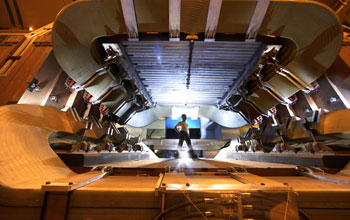
The LHCb (Large Hadron Collider beauty) experiment is one of eight particle physics detector experiments collecting data at the Large Hadron Collider at CERN. LHCb is a specialized b-physics experiment, designed primarily to measure the parameters of CP violation in the interactions of b-hadrons (heavy particles containing a bottom quark). Such studies can help to explain the matter-antimatter asymmetry of the Universe. The detector is also able to perform measurements of production cross sections, exotic hadron spectroscopy, charm physics and electroweak physics in the forward region. The LHCb collaboration, who built, operate and analyse data from the experiment, is composed of approximately 1260 people from 74 scientific institutes, representing 16 countries.
The fact that the two b-hadrons are predominantly produced in the same forward cone is exploited in the layout of the LHCb detector. The LHCb detector is a single arm forward spectrometer with a polar angular coverage from 10 to 300 milliradians (mrad) in the horizontal and 250 mrad in the vertical plane. The asymmetry between the horizontal and vertical plane is determined by a large dipole magnet with the main field component in the vertical direction.
Picture Credit : Google




